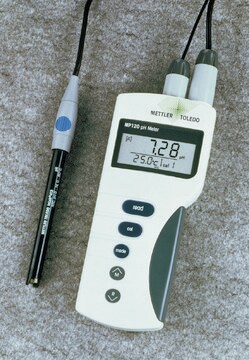The maximum size of cell clumps that can pass through the Scepter 3.0 is determined by the aperture limits, which are 40um and 60um for sensors 40 and 60, respectively. Unlike the Scepter 2.0, the Scepter 3.0 does not use a screen to break up cell clump aggregates; instead, it employs a set of pillars to achieve this function. In contrast, the Scepter 2.0 utilizes a 35um Nylon filter to break up cell clump aggregates.
PHCC360KIT
Compteur de cellules automatisé portatif Scepter 3.0
Rapid cell counts in a handheld easy to use format, includes pkg of 60 μm Scepter 3.0 Cell Counter Sensors
Synonyme(s) :
Cell counting instrument
Sélectionner une taille de conditionnement
4 170,00 €
Sélectionner une taille de conditionnement
About This Item
4 170,00 €
Produits recommandés
Fabricant/nom de marque
Scepter
Technique(s)
cell counting: suitable
Taille des particules
6-36 μm
Compatibilité
for use with cells sized 4.0–25.0 μm
Conditions d'expédition
ambient
Description générale
- Concentration de cellules
- Taille moyenne des cellules
- Volume cellulaire moyen
- Histogramme de la répartition de la taille ou du volume
Le compteur de cellules Scepter 3.0 est compatible avec les sondes pour compteur de cellules Scepter 3.0 40 µM et 60 µM. Ce kit (réf. PHCC360KIT) contient un paquet gratuit de 50 sondes 60 µM.
Composants
- 1 compteur de cellules automatisé portatif Scepter 3.0
- 1 fiole de billes de test
- 1 station de charge
- 50 sondes (60 µM)
Autres remarques
À utiliser avec
Code de la classe de stockage
10-13 - German Storage Class 10 to 13
Classe de danger pour l'eau (WGK)
WGK 1
Point d'éclair (°F)
Not applicable
Point d'éclair (°C)
Not applicable
Certificats d'analyse (COA)
Recherchez un Certificats d'analyse (COA) en saisissant le numéro de lot du produit. Les numéros de lot figurent sur l'étiquette du produit après les mots "Lot" ou "Batch".
Déjà en possession de ce produit ?
Retrouvez la documentation relative aux produits que vous avez récemment achetés dans la Bibliothèque de documents.
Articles
Data for validated human cell lines using the Millicell® DCI Digital Cell Imager for confluency determination and estimated cell counts.
Find answers to frequently asked questions about the Millicell® ERS 3.0, from probe depth adjustment to instrument maintenance and troubleshooting.
Learn how Sterivex™ pressure-driven sterile filters can be used for large-volume sample processing in environmental research and testing.
The Scepter™ 3.0 Cell Counter, when used in conjunction with a 40 μm aperture sensor, can accurately count and precisely size a wide range of cell types and particles. This application note demonstrates two examples of experiments using the instrument’s sensitive size-discriminating capacity for rapid qualitative assessment of individual cell populations.
Protocoles
Cell culture protocol for passaging and splitting adherent cell lines using trypsin EDTA. Free ECACC handbook download.
Contenu apparenté
Rationalisez la capture et l'analyse des données de mesure de la TEER grâce à des améliorations conviviales, notamment une interface tactile intuitive, une sonde autonome dans les puits et l'enregistrement automatique des données.
Monitor your cell cultures with ease with the Millicell® DCI Digital Cell Imager. From confluency to cell count and morphology, the Millicell® DCI automates cell culture measurements for quicker, more consistent culturing.
Scepter™ Cell Counter is a portable device which brings consistency in cell counting right to the culture hood in less than 30 seconds.
Scepter™ counting is 7 to 10 times faster than hemocytometry-and also faster than other automated counters. Learn more about how this amazing technology works
-
What is the maximum size of cell clumps that can pass through the Scepter 3.0? Also, what size screen is used to break up the cell clump aggregates in both Scepter 2.0 and 3.0?
1 answer-
Helpful?
-
-
Is this appropriate for size 15-23 μm cell? Does the Kit include also the charger? How many 60/40 μm sensors are included Which sensors can be used with this instrument? Which sensors are appropriate for cells size 15-23 μm and what is their price?
1 answer-
Please see the answers to the following questions below:
1. Is this appropriate for size 15-23 μm cells?
Yes, the Scepter 3.0 is suitable. As listed on the product detail page in the DESCRIPTION section for use with cells sized 4.0–25.0 μm.2. Does the Kit include the charger?
This product does include 60μM sensors and a charging station.3. How many 60/40 μm sensors are included
As mentioned on the product detail page in the DESCRIPTION section under 'Components', it includes 50 Sensors.4. Which sensors can be used with this instrument?
This product is only compatible with Scepter 3.0 Cell Counter Sensors shown in the Related Products on this page. Please see the link below to review additional information regarding the Scepter 3.0:
https://www.sigmaaldrich.com/US/en/technical-documents/technical-article/cell-culture-and-cell-culture-analysis/cell-counting-and-health-analysis/scepter-cell-counter5. Which sensors are appropriate for cells size 15-23 μm and what is their price?
See question 1, this product is suitable for the cell size of 15-23 μm.Regarding pricing, Please navigate to the link https://www.sigmaaldrich.com/support/customer-support, and click on "Products Pricing & Availability" under the Products Section with all the required information so that a member of the Customer Service team can reach out to assist further. Thank you.
Helpful?
-
-
Does it require Trypan blue or another dye? Does it distinguish between live and dead cells?
1 answer-
The Scepter is a particle counter, but it will not differentiate live from dead cells. The device can be used to gauge cell health on the basis of cell size. For example, in cell types where apoptotic cells are smaller in size compared to non-apoptotic cells. This shift in size can be quantified using the device option "Edit Histogram" to either gate around this population or exclude the population from the count.
Please see the following manual below for more information:
https://www.sigmaaldrich.com/deepweb/assets/sigmaaldrich/product/documents/799/484/00110230w-rev1020-ms.pdfHelpful?
-
Active Filters
Notre équipe de scientifiques dispose d'une expérience dans tous les secteurs de la recherche, notamment en sciences de la vie, science des matériaux, synthèse chimique, chromatographie, analyse et dans de nombreux autres domaines..
Contacter notre Service technique






